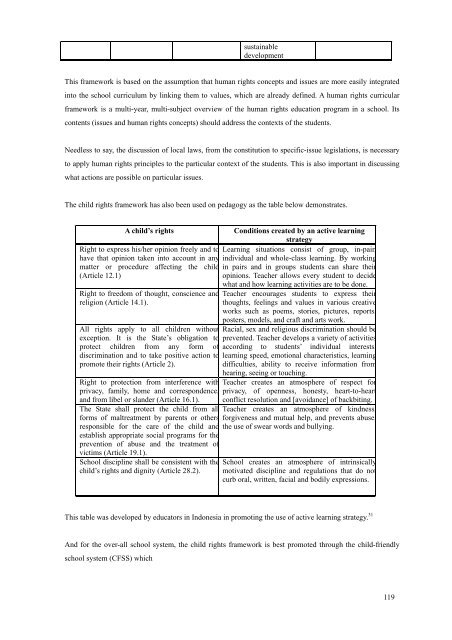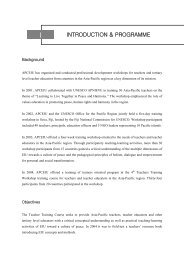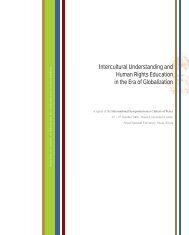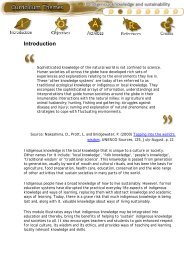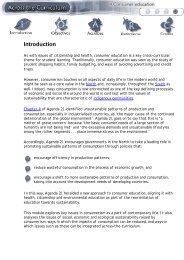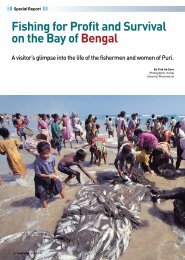REPORT OF UNESCO EXPERT MEETING ON - APCEIU
REPORT OF UNESCO EXPERT MEETING ON - APCEIU
REPORT OF UNESCO EXPERT MEETING ON - APCEIU
You also want an ePaper? Increase the reach of your titles
YUMPU automatically turns print PDFs into web optimized ePapers that Google loves.
sustainable<br />
development<br />
This framework is based on the assumption that human rights concepts and issues are more easily integrated<br />
into the school curriculum by linking them to values, which are already defined. A human rights curricular<br />
framework is a multi-year, multi-subject overview of the human rights education program in a school. Its<br />
contents (issues and human rights concepts) should address the contexts of the students.<br />
Needless to say, the discussion of local laws, from the constitution to specific-issue legislations, is necessary<br />
to apply human rights principles to the particular context of the students. This is also important in discussing<br />
what actions are possible on particular issues.<br />
The child rights framework has also been used on pedagogy as the table below demonstrates.<br />
A child’s rights<br />
Right to express his/her opinion freely and to<br />
have that opinion taken into account in any<br />
matter or procedure affecting the child<br />
(Article 12.1)<br />
Right to freedom of thought, conscience and<br />
religion (Article 14.1).<br />
All rights apply to all children without<br />
exception. It is the State’s obligation to<br />
protect children from any form of<br />
discrimination and to take positive action to<br />
promote their rights (Article 2).<br />
Right to protection from interference with<br />
privacy, family, home and correspondence,<br />
and from libel or slander (Article 16.1).<br />
The State shall protect the child from all<br />
forms of maltreatment by parents or others<br />
responsible for the care of the child and<br />
establish appropriate social programs for the<br />
prevention of abuse and the treatment of<br />
victims (Article 19.1).<br />
School discipline shall be consistent with the<br />
child’s rights and dignity (Article 28.2).<br />
Conditions created by an active learning<br />
strategy<br />
Learning situations consist of group, in-pair,<br />
individual and whole-class learning. By working<br />
in pairs and in groups students can share their<br />
opinions. Teacher allows every student to decide<br />
what and how learning activities are to be done.<br />
Teacher encourages students to express their<br />
thoughts, feelings and values in various creative<br />
works such as poems, stories, pictures, reports,<br />
posters, models, and craft and arts work.<br />
Racial, sex and religious discrimination should be<br />
prevented. Teacher develops a variety of activities<br />
according to students’ individual interests,<br />
learning speed, emotional characteristics, learning<br />
difficulties, ability to receive information from<br />
hearing, seeing or touching.<br />
Teacher creates an atmosphere of respect for<br />
privacy, of openness, honesty, heart-to-heart<br />
conflict resolution and [avoidance] of backbiting.<br />
Teacher creates an atmosphere of kindness,<br />
forgiveness and mutual help, and prevents abuse,<br />
the use of swear words and bullying.<br />
School creates an atmosphere of intrinsically<br />
motivated discipline and regulations that do not<br />
curb oral, written, facial and bodily expressions.<br />
This table was developed by educators in Indonesia in promoting the use of active learning strategy. 31<br />
And for the over-all school system, the child rights framework is best promoted through the child-friendly<br />
school system (CFSS) which<br />
119


